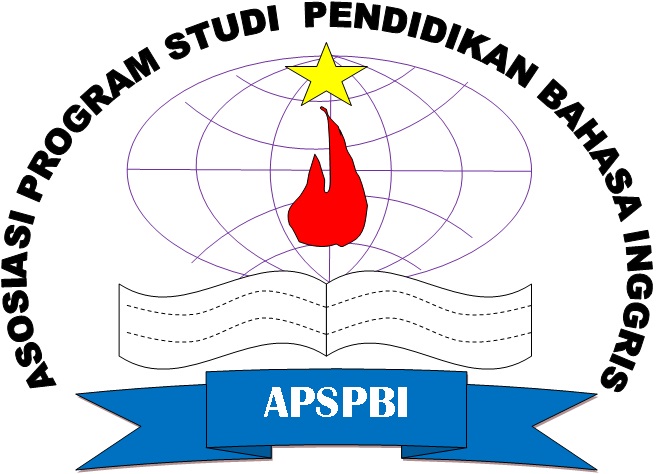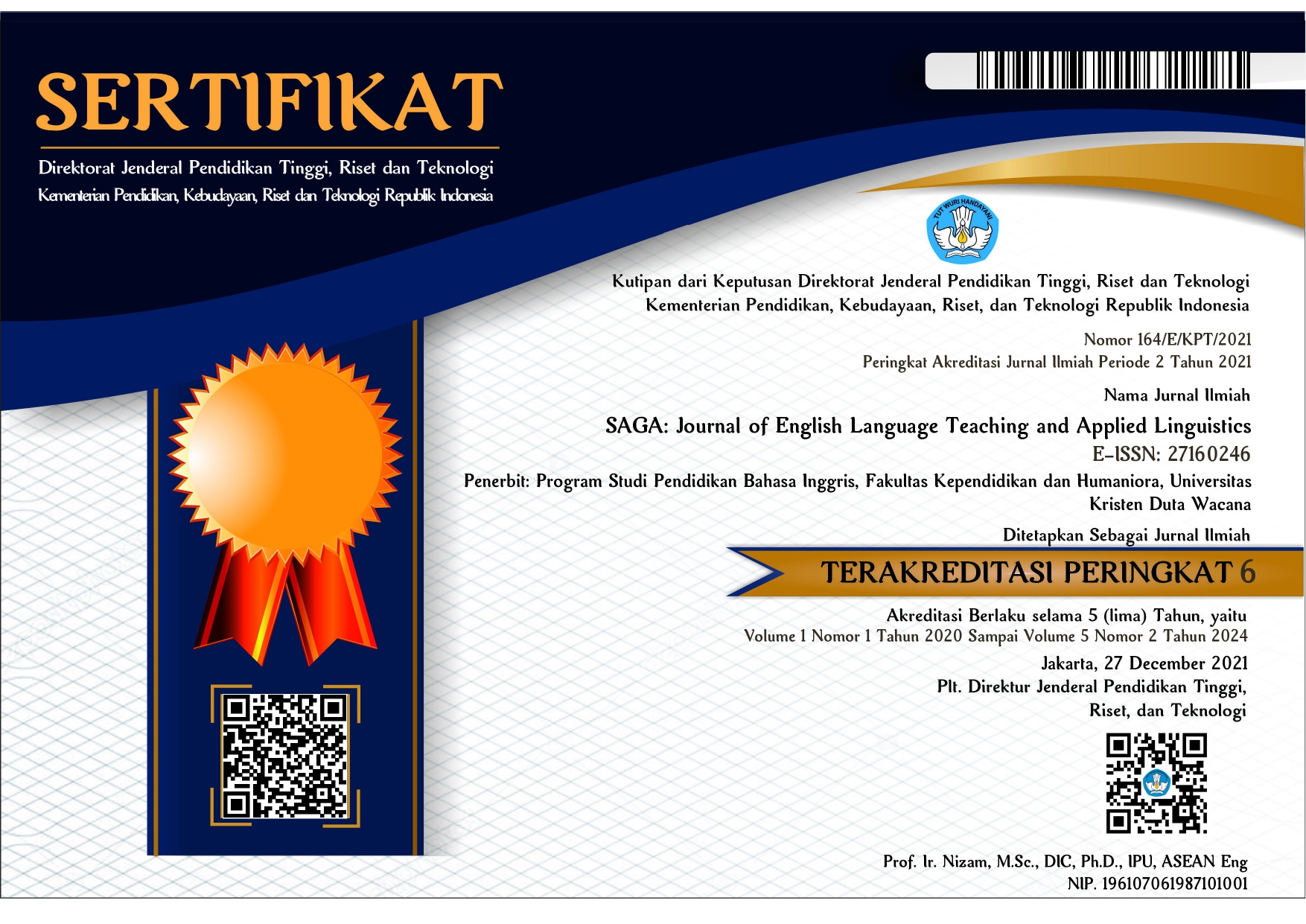Teaching Indonesian L2 Learners Academic Writing: A Proposed Instructional Model
DOI:
https://doi.org/10.21460/saga.2022.32.134Keywords:
L2 academic writing, instructional model, peer reviews, academic readingAbstract
This article reports a proposed instructional model to teach the second language (L2) academic writing in education with citations and references to learners in English Education departments. The model is suggested to be implemented in two semesters in a row. In the first semester of the implementation, learners are to take essay writing and academic reading courses simultaneously. In the former, learners learn to write coherent and cohesive sandwich paragraphs, do peer reviews, and write five-paragraph essays in education without citations and references. In the latter, learners familiarise themselves with various academic sources, write in-text citations and reference lists using Microsoft Word Reference Manager, paraphrase and summarise information from journal articles, and write a short paragraph using citations and references. In the second semester of the implementation of the model, learners take an academic essay writing course which is the progressing combination of the two aforementioned courses in the previous semesters. In this writing course, learners write two 1,200-word essays in education with citations and references from at least five sources. During the implementation of the model, a no-plagiarism policy is upheld through teachers' emphasising on paraphrasing and checking learners' works with plagiarism checkers before submission. Gradual progress is continuously monitored through teachers' feedback on progress. All in all, the model emphasises step-by-step progress in L2 academic writing supported by ample writing preparation time and continuous feedback on progress.
References
Ahmed, H. (2010). Students’ problems with cohesion and coherence in EFL essay writing in Egypt: Different perspectives. Literacy Information and Computer Education Journal (LICEJ), 1, 211–221.
Bakhtiyari, K., Salehi, H., Embi, M. A., Shakiba, M., Zavvari, A., Shahbazi-Moghadam, M., Ebrahim, N. A., & Mohammadjafari, M. (2014). Ethical and unethical methods of plagiarism prevention in academic writing. International Education Studies, 7(7), 52–62. https://doi.org/10.5539/ies.v7n7p52
Harzing, A. W. (2018). How to keep up to date with the literature but avoid information overload. LSE. https://blogs.lse.ac.uk/impactofsocialsciences/2018/05/18/how-to-keep-up-to-date-with-the-literature-but-avoid-information-overload/
Hyland, K. (2003). Second language writing. Cambridge University Press.
Kristiyanti, K. L., Santosa, M. H., & Pratiwi, N. P. A. (2021). Students’ perception towards the implementation of online formative assessment in English learning. Journal of Educational Study, 1(2), 68–76. https://doi.org/10.36663/joes.v1i2.155
McLucas, M. A. (2021). Adopting a basic student peer review process in EAP A/B writing. Reports from English Teachers’ Seminars, 4, 20–29.
Microsoft. (2022). Create a bibliography, citations, and references. Microsoft Support. https://support.microsoft.com/en-us/office/create-a-bibliography-citations-and-references-17686589-4824-4940-9c69-342c289fa2a5
Miller, R. T., & Pessoa, S. (2016). Where’s your thesis statement and what happened to your topic sentences? Identifying organizational challenges in undergraduate student argumentative writing. TESOL Journal, 7(4), 847–873. https://doi.org/10.1002/tesj.248
Nugraha, I. G. N. A. R. D., Santosa, M. H., & Paramartha, A. A. G. Y. (2020). A study of Indonesian lecturers’ perception on student plagiarism. SAGA: Journal of English Language Teaching and Applied Linguistics, 1(2), 81–94. https://doi.org/10.21460/saga.2020.12.53
Saint Mary’s College of California Library. (2020). APA style 7th edition. https://www.stmarys-ca.edu/sites/default/files/attachments/files/apa7threv.pdf.
Savage, A., & Mayer, P. (2005). Effective academic writing 2: the short essay. Oxford University Press.
Savage, A., & Shafiei, M. (2007). Effective academic writing 1: the paragraph. Oxford University Press.
Shukri, N. A. (2014). Second language writing and culture: Issues and challenges from the Saudi learners’ perspective. Arab World English Journal, 3(9), 190–207.
Snyder, H. (2019). Literature review as a research methodology: An overview and guidelines. Journal of Business Research, 104, 333–339. https://doi.org/10.1016/j.jbusres.2019.07.039
Stæhr, L. S. (2008). Vocabulary size and the skills of listening, reading and writing. Language Learning Journal, 36(2), 139–152. https://doi.org/10.1080/09571730802389975
Steinman, L. (2003). Cultural collisions in L2 academic writing. TESL Canada Journal, 20(2), 80–91. https://doi.org/10.18806/tesl.v20i2.950
Subekti, A. S. (2017). A study of the mastery of complex sentences of pre-service English teachers. Ahmad Dahlan Journal of English Studies (ADJES), 4(2), 1–12.
Subekti, A. S. (2018a). Error analysis in complex sentences written by Indonesian students from the English Education Department. Studies in English Language and Education, 5(2), 185–203.
Subekti, A. S. (2018b). L2 writing proficiency and mastery of complex sentence: A study of Indonesian English education major university students. IJEFL (Indonesian Journal of EFL and Linguistics), 3(1), 19–32.
Subekti, A. S. (2022). Pre-service English teachers’ experiences of peer-reviewing in L2 writing. Jurnal Pendidikan Indonesia, 11(1), 96–106.
Tree, J. E. F., & Clark, N. B. (2013). Communicative effectiveness of written versus spoken feedback. Discourse Processes, 50(5), 339–359. https://doi.org/10.1080/0163853X.2013.797241
Wang, M. (2011). Chinese postgraduate students learning to write in English: Toward an understanding of L2 academic writing. In P. L. Ha & B. Baurain (Eds.), Voices, identities, negotiations, and conflicts: Writing academic English across cultures.
Wang, Y. (2012). Differences in L1 and L2 academic writing. Theory and Practice in Language Studies, 2(3), 637–641. https://doi.org/10.4304/tpls.2.3.637-641
Well, E. (2013). How to write a sandwich paragraph. QEP Writing Studio Use. https://www.ecsu.edu/documents/qep/sandwichParagraph.pdf
Wen, Y. (2013). Teacher written feedback on L2 student writings. Journal of Language Teaching and Research, 4(2), 427–431. https://doi.org/10.4304/jltr.4.2.427-431
Whitaker, E. E. (1992). The quick fix: Developing paragraphs with the rhetorical sandwich. College Teaching, 40(4), 141–141. https://doi.org/10.1080/87567555.1992.10532236
Yusuf, Q., Yusuf, Y. Q., Yusuf, B., & Nadya, A. (2017). Skimming and scanning techniques to assist EFL students in understanding English reading texts. Indonesian Research Journal in Education| IRJE|, 1(1), 43–57.
Zhang, Z. V., & Hyland, K. (2018). Student engagement with teacher and automated feedback on L2 writing. Assessing Writing, 36, 90–102. https://doi.org/10.1016/j.asw.2018.02.004
Zhu, Q., & Carless, D. (2018). Dialogue within peer feedback processes: Clarification and negotiation of meaning. Higher Education Research & Development, 0(0), 1–15. https://doi.org/10.1080/07294360.2018.1446417
















